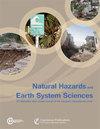Scenario-based multi-risk assessment from existing single-hazard vulnerability models. An application to consecutive earthquakes and tsunamis in Lima, Peru
IF 4.7
2区 地球科学
Q1 GEOSCIENCES, MULTIDISCIPLINARY
引用次数: 2
Abstract
Abstract. Multi-hazard risk assessments for building portfolios exposed to earthquake shaking followed by a tsunami are usually based on empirical vulnerability models calibrated on post-event surveys of damaged buildings. The applicability of these models cannot easily be extrapolated to other regions of larger/smaller events. Moreover, the quantitative evaluation of the damages related to each of the hazard types (disaggregation) is impossible. To investigate cumulative damage on extended building portfolios, this study proposes an alternative and modular method to probabilistically integrate sets of single-hazard vulnerability models that are constantly being developed and calibrated by experts from various research fields to be used within a multi-risk context. This method is based on the proposal of state-dependent fragility functions for the triggered hazard to account for the pre-existing damage and the harmonisation of building classes and damage states through their taxonomic characterisation, which is transversal to any hazard-dependent vulnerability. This modular assemblage also allows us to separate the economic losses expected for each scenario on building portfolios subjected to cascading hazards. We demonstrate its application by assessing the economic losses expected for the residential building stock of Lima, Peru, a megacity commonly exposed to consecutive earthquake and tsunami scenarios. We show the importance of accounting for damage accumulation on extended building portfolios while observing a dependency between the earthquake magnitude and the direct economic losses derived for each hazard scenario. For the commonly exposed residential building stock of Lima exposed to both perils, we find that classical tsunami empirical fragility functions lead to underestimations of predicted losses for lower magnitudes (Mw) and large overestimations for larger Mw events in comparison to our state-dependent models and cumulative-damage method.基于现有单一危险脆弱性模型的基于场景的多风险评估。秘鲁利马连续地震和海啸的应用
摘要建筑组合在地震和海啸中的多重危险性评估通常基于基于受损建筑事后调查校准的单一脆弱性模型。这些模型的适用性不能很容易地外推到较大/较小事件的其他区域。此外,不可能对与每种危险类型相关的损害进行定量评估(分解)。为了调查扩展建筑组合的累积损失,本研究提出了一种替代和模块化的方法,以概率地集成来自各个研究领域的专家不断开发和校准的一组单一危险脆弱性模型,以在多风险背景下使用。该方法基于触发危险的状态相关脆弱性函数的建议,以解释预先存在的损害,并通过其分类特征来协调建筑类别和损害状态,这与任何危险相关的脆弱性都是横向的。这种模块化组合还使我们能够在受到级联危险的建筑投资组合中分离出每种情况下的预期经济损失。我们通过评估秘鲁利马住宅建筑存量的预期经济损失来演示它的应用,利马是一个经常面临连续地震和海啸情景的特大城市。我们展示了计算扩展建筑组合的损失累积的重要性,同时观察了地震震级和每种危险情况下产生的直接经济损失之间的相关性。对于利马常见的暴露在这两种危险中的相同建筑存量,我们发现,与我们的状态相关模型和累积损伤方法相比,经典的海啸经验脆弱性函数导致低估了较低震级(Mw)的预测损失,并大大高估了较大震级事件的预测损失。
本文章由计算机程序翻译,如有差异,请以英文原文为准。
求助全文
约1分钟内获得全文
求助全文
来源期刊
CiteScore
7.60
自引率
6.50%
发文量
192
审稿时长
3.8 months
期刊介绍:
Natural Hazards and Earth System Sciences (NHESS) is an interdisciplinary and international journal dedicated to the public discussion and open-access publication of high-quality studies and original research on natural hazards and their consequences. Embracing a holistic Earth system science approach, NHESS serves a wide and diverse community of research scientists, practitioners, and decision makers concerned with detection of natural hazards, monitoring and modelling, vulnerability and risk assessment, and the design and implementation of mitigation and adaptation strategies, including economical, societal, and educational aspects.

 求助内容:
求助内容: 应助结果提醒方式:
应助结果提醒方式:


